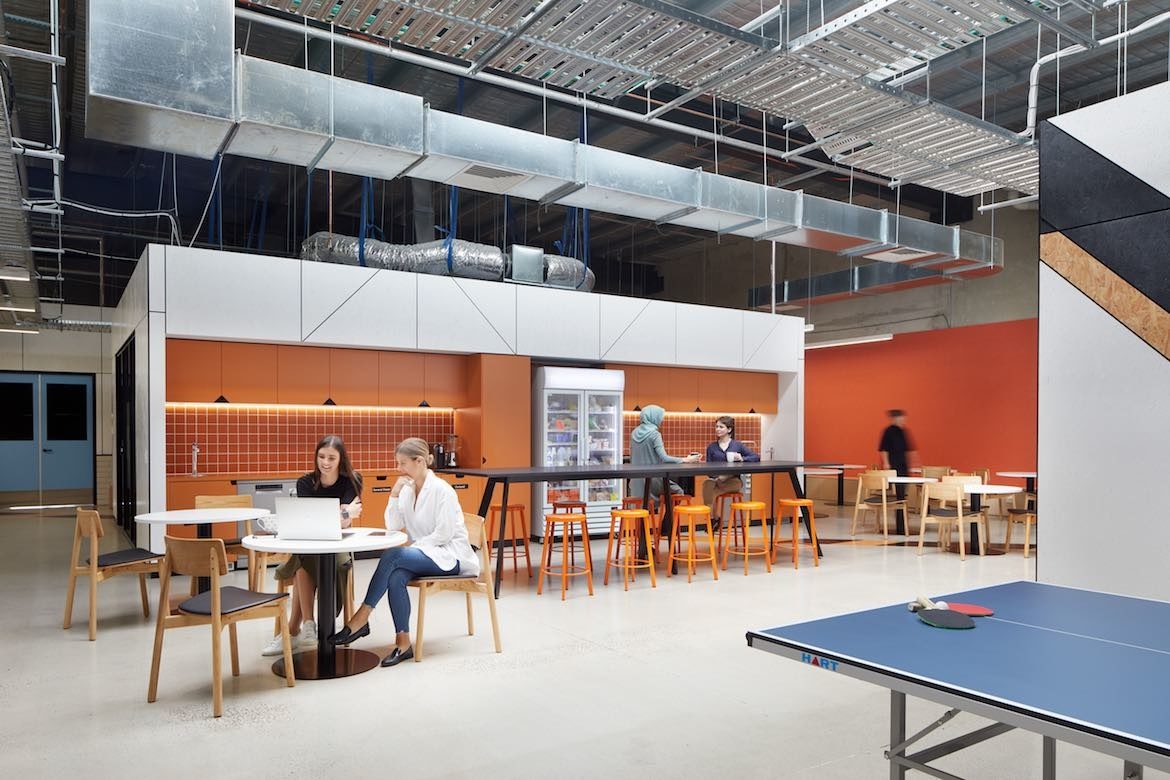Research by Gray Puksand found that a sensitive, community-focussed approach was key to ensuring alternative flexible education schools best support students, Mark Freeman reports.

December 13th, 2021
Engaging learning environments create a sense of place, purpose and community for all students and staff. The research and design process undertaken through our recent project, Hester Hornbrook Academy (HHA), demonstrates the importance of authentic inclusive design.
By understanding the diverse experiences, backgrounds and needs of students, our team has been able to design a campus which promotes connection and collaboration, fosters a sense of safety and belonging, helping to unify varied personalities, and respectful of the needs of all.
Alternate flexible education settings cater for groups not typically acknowledged in the dialogue of contemporary educational design. These may be young parents, currently in or living out of home care, young people living with mental health conditions, experiencing homelessness, or disengaged from mainstream education.

Our driving question across the briefing and design process for this unique campus was ‘How can the function and design of alternative flexible education schools better support students through an enriching educational experience both in and beyond the classroom?’ What we found was that a sensitive, community-focussed approach was key.
These schools need to be specifically designed to reflect a relational pedagogy, encompassing the broader support network of staff and community wellbeing services built around the students. The sites also need to feature a variety of learning hubs, mindfulness spaces and recreational facilities to empower students to engage with, and take control of their educational journey.
Inclusive and trauma-informed design principles were the foundation for HHA, and we worked closely with the Hester Hornbrook team to realise these outcomes.
The Academy was designed to provide a feeling of wellbeing, safety and sense of home. Its domestic scale features learning spaces positioned strategically throughout the site, connected via interstitial, activated and legible circulation spaces.

This activation and visibility provide formal and informal connection, whilst supporting a sense of security for students. Spaces for students to socialise, to eat, to prepare food along with spaces for students to shower and launder acknowledge the diverse needs of the student community.
The interior design offers a calm sensory stimulation for students throughout the day. Study areas have been created with a range of furniture options and a balanced mix of colour hues, materials and textural finishes. This variety gives students the choice of which spaces they use, and more importantly, how they are able to use them.
Biophilia is another expression of inclusive design considered throughout The Academy, promoting the physical and mental wellbeing of students.
The use of plants and greenery promotes mindfulness through a connection to nature, and these nature motifs extend to other interior details like furniture upholstery and calming colour palettes. Balancing and integrating these design cues is important for a project of this type.
The campus’ functional planning also highlights how strategic use and placement of informal and formal learning settings can provide students a sense of freedom, while still offering security both internally and externally.

The Academy’s indoor-outdoor transition and breakout space is complemented by a series of pavilions, ensuring students have ongoing engagement with new spaces and activities throughout their day without being disconnected from the main building.
Offering functional spaces for student wellbeing programs in the school’s curriculum, like physical activity and team building, were a key component supporting a vibrant campus culture and community. An internal basketball court, fitness rooms and impromptu recreation spaces encourage healthy work-play habits for students and support positive lifestyle practices which students will adopt for life.
From a broader perspective, Hester Hornbrook Academy’s design also celebrates its locational context. It was designed to reflect the vibrant Sunshine community and its values, standing proudly as a place that people across all social and cultural backgrounds are inspired to engage with.
Inclusive design is the way forward for alternative flexible education schools. We are privileged to be designing learning environments in which some of our most challenged students have best possible opportunity to thrive.
These projects are among some of our most rewarding, and we look forward to seeing how our research and learnings promote a progressive design direction for alternative learning environments of this type in the future.
Gray Puksand
graypuksand.com.au
Mark Freeman is a partner with Gray Puksand. He has over 15 years of architecture experience in the planning and design of innovative and sustainable education facilities.
INDESIGN is on instagram
Follow @indesignlive
A searchable and comprehensive guide for specifying leading products and their suppliers
Keep up to date with the latest and greatest from our industry BFF's!

A longstanding partnership turns a historic city into a hub for emerging talent
The new range features slabs with warm, earthy palettes that lend a sense of organic luxury to every space.

BLANCOCULINA-S II Sensor promotes water efficiency and reduces waste, representing a leap forward in faucet technology.

How can design empower the individual in a workplace transforming from a place to an activity? Here, Design Director Joel Sampson reveals how prioritising human needs – including agency, privacy, pause and connection – and leveraging responsive spatial solutions like the Herman Miller Bay Work Pod is key to crafting engaging and radically inclusive hybrid environments.

A new STEAM project by Life Architecture and Urban Design for St Columba’s College, in Essendon, Victoria is education design at its best.

A new $67.6 million facility at Chisholm Institute’s Frankston campus in Victoria marks a shift in how vocational education is delivered in Australia.
The internet never sleeps! Here's the stuff you might have missed

The collaboration between Nexus Designs and Cultivated challenge conventional design practices, offering tangible solutions for the industry’s sustainability challenges.

The Naomi Milgrom Foundation has announced that the MPavilion, designed by Tadao Ando, will stay in Queen Victoria Gardens for five more years.